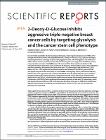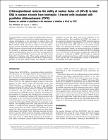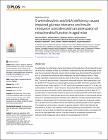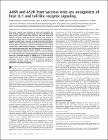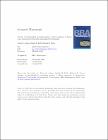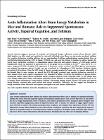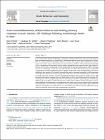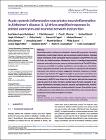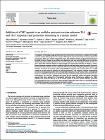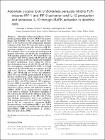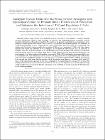Browsing Biochemistry (Scholarly Publications) by Title
Now showing items 1-20 of 724
-
2-Deoxy-D-Glucose inhibits aggressive triple-negative breast cancer cells by targeting glycolysis and the cancer stem cell phenotype
(2019)Due to limited availability of pharmacological therapies, triple-negative breast cancer (TNBC) is the subtype with worst outcome. We hypothesised that 2-Deoxy-D-Glucose (2-DG), a glucose analogue, may hold potential as a ... -
2-mercaptoethanol restores the ability of nuclear factor kappa B (NF kappa B) to bind DNA in nuclear extracts from interleukin 1-treated cells incubated with pyrollidine dithiocarbamate (PDTC)
(Portland Press, 1997)The metal chelator and anti-oxidant pyrollidine dithiocarbamate (PDTC) has been used extensively in studies implicating reactive oxygen intermediates in the activation of nuclear factor kappa B (NF kappa B). In agreement ... -
3-Vinylazetidin-2-Ones: Synthesis, antiproliferative and tubulin destabilizing activity in MCF-7 and MDA-MB-231 Breast Cancer Cells
(MDPI, 2019)Microtubule-targeted drugs are essential chemotherapeutic agents for various types of cancer. A series of 3-vinyl-β-lactams (2-azetidinones) were designed, synthesized and evaluated as potential tubulin polymerization ... -
5-aminolevulinic acid (ALA) deficiency causes impaired glucose tolerance and insulin resistance coincident with an attenuation of mitochondrial function in aged mice
(2018)In vertebrates, the initial step in heme biosynthesis is the production of 5-aminolevulinic acid (ALA) by ALA synthase (ALAS). ALA formation is believed to be the rate-limiting step for cellular heme production. Recently, ... -
A46R and A52R from vaccinia virus are antagonists of host IL-1 and toll-like receptor signaling
(2000)Poxviruses employ many strategies to evade and neutralize the host immune response. In this study, we have identified two vaccinia virus ORFs, termed A46R and A52R, that share amino acid sequence similarity with the Toll/IL-1 ... -
Absence of Mitochondrial Uncoupling Protein 1 Affects Apoptosis in Thymocytes, Thymocyte/T-Cell profile and Peripheral T-Cell Number
(Elsevier, 2010)Our laboratory has previously demonstrated the presence of constitutively expressed mitochondrial uncoupling protein 1 in mouse thymocytes. In our endeavours to understand the role of mitochondrial uncoupling protein 1 in ... -
Absence of mitochondrial uncoupling protein 3: Effect on thymus and spleen in the fed and fasted mice
(2011)Mitochondrial uncoupling protein 3 (UCP3) is consituitively expressed in mitochondria from thymus and spleen of mice, and confocal microscopy has been used to visualize UCP3 in situ in mouse thymocytes. UCP3 is present ... -
Activation of biliverdin-IXα reductase by inorganic phosphate and related anions
(2007)The effect of pH on the initial-rate kinetic behaviour of BVR-A (biliverdin-IX? reductase) exhibits an alkaline optimum with NADPH as cofactor, but a neutral optimum with NADH as cofactor. This has been described as dual ... -
Activation of host pattern recognition receptors by viruses
(2010)Viral recognition by the host innate immune system has become an exciting and growing area of research focus in recent years. It is now apparent that multiple pattern recognition receptor (PRR) families, including Toll-like ... -
Activation of human invariant natural killer T cells with a thioglycoside analogue of ?-galactosylceramide
(2011)Activation of CD1d-restricted invariant NKT (iNKT) cells with the glycolipid ?-galactosylceramide (?-GalCer) confers protection against disease in murine models, however, clinical trials in humans have had limited impact. ... -
Activation of mixed glia by A-beta-specific Th1 and Th17 cells and its regulation by Th2 cells
(2010)Microglia are innate immune cells of the CNS, that act as antigen-presenting cells (APC) for antigen-specific T cells and respond to inflammatory stimuli, such as amyloid-beta (A?), resulting in the release of neurotoxic ... -
Acute Inflammation Alters Brain Energy Metabolism in Mice and Humans: Role in Suppressed Spontaneous Activity, Impaired Cognition, and Delirium
(2020)Systemic infection triggers a spectrum of metabolic and behavioral changes, collectively termed sickness behavior, which while adaptive, can affect mood and cognition. In vulnerable individuals, acute illness can also ... -
Acute neuroinflammation, sickness behavior and working memory responses to acute systemic LPS challenge following noradrenergic lesion in mice
(2021)Locus coeruleus (LC)-derived noradrenaline is important in cognition and decreases with age, but the impact of prior noradrenaline deficiency on vulnerability to inflammation-induced acute cognitive dysfunction is ... -
Acute systemic inflammation exacerbates neuroinflammation in Alzheimer's disease: IL-1?? drives amplified responses in primed astrocytes and neuronal network dysfunction
(2021)Neuroinflammation contributes to Alzheimer’s disease (AD) progression. Secondary inflammatory insults trigger delirium and can accelerate cognitive decline. Individual cellular contributors to this vulnerability require ... -
Acute transient cognitive dysfunction and acute brain injury induced by systemic inflammation occur by dissociable IL-1-dependent mechanisms
(2018)Systemic inflammation can impair cognition with relevance to dementia, delirium and post-operative cognitive dysfunction. Episodes of delirium also contribute to rates of long-term cognitive decline, implying that these ... -
Adenosine-mono-phosphate-activated protein kinase-independent effects of metformin in T cells.
(2014)The anti-diabetic drug metformin regulates T-cell responses to immune activation and is proposed to function by regulating the energy-stress-sensing adenosine-monophosphate-activated protein kinase (AMPK). However, the ... -
Adenylate cycalse toxin of Bordetella pertussis inhibits TLR-induced IRF-1 and IRF-8 activation and IL-12 production and enhances IL-10 through MAPK activation in dendritic cells
(Society of Leukocyte Biology, 2008)Adenylate cyclase toxin (CyaA) of Bordetella pertussis binds to CD11b/CD18 on macrophages and dendritic cells (DC) and confers virulence to the bacteria by subverting innate immune responses of the host. We have previously ... -
Adenylate cyclase toxin from Bordetella pertussis synergises with lipopolysaccharide to promote innate IL-10 production and enhance the induction of Th2 and regulatory T cells
(American Society for Microbiology, 2004)Adenylate cyclase toxin (CyaA) from Bordetella pertussis can subvert host immune responses allowing bacterial colonization. Here we have examined its adjuvant and immunomodulatory properties and the possible contribution ...




